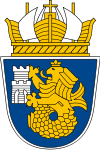Burgas
| Burgas Бургас |
|||
|
|||
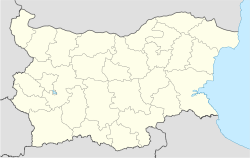 Burgas
|
|||
| Coordinates: | |||
| Country | |||
|---|---|---|---|
| Provinces (Oblast) |
Burgas | ||
| Government | |||
| - Mayor | Dimitar Nikolov | ||
| Elevation | 30 m (98 ft) | ||
| Population (2007-15-07) | |||
| - Total | 229,250 | ||
| Time zone | EET (UTC+2) | ||
| - Summer (DST) | EEST (UTC+3) | ||
| Postal Code | 8000 | ||
| Area code(s) | 056 | ||

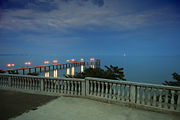

Burgas (Bulgarian: Бургас, sometimes transliterated as Bourgas) is the second-largest city and seaside resort on the Bulgarian Black Sea Coast with population 210,260. It is also the fourth-largest by population in the country, after Sofia, Plovdiv and Varna. It is the capital of Burgas Province and an industrial and tourist centre.
Surrounded by the coastal Burgas Lakes and located at the westernmost point of the Black Sea, the large Burgas Bay, Burgas has the largest and most important Bulgarian port. Today, it is a key economic, cultural and tourist centre of southeastern Bulgaria, with the Burgas Airport serving the resorts of the southern Bulgarian coast.
Contents |
History

Burgas is a successor of the Ancient Greek city of Pyrgos (Πύργος), founded by colonists from Apolonia as a military and observational post against the other important settlement in the region — Mesembria. Besides Pirgos, the present-day city expands over the area of three other ancient settlements: Castrition, Skafida and Rossokastron.
During the rule of the Ancient Romans, Burgas was known as Deultum, and was established as a military colony for veterans by Vespasian. In the Middle Ages, a small fortress called Pirgos (Πύργος being Greek for "tower") was erected on the place and was most probably used as a watchtower. It was only in the 17th century that a settlement named Ahelo-Pirgas grew in the modern area of the city. It was later renamed to Bourgas and had only about 3,000 inhabitants, most of them Greeks at the time of the Liberation.
Later, it became a major centre on the southern Bulgarian Black Sea Coast and a city of well-developed industry and trade. A number of oil and chemical companies were gradually built. Salt and iron are also mined and traded abroad.


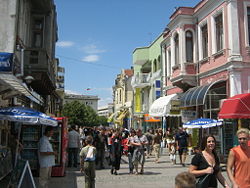

In the early 1800s Burgas was depopulated after raids by kurzdhali bandits. By the mid 19th century it had recovered its economic prominence through the growth of craftsmanship and the export of grain.[1]
In 19th century, with the increasing maritime trade in the Black Sea Burgas became one of the most important port-cities. However, it has lost some of its importance with the shift of the trade between Balkans-Istanbul-Trabzon to Southern port-cities with the construction of Salonica-Istanbul railways. In 1903, the railway station in Burgas opened, giving an additional boost to the city's expansion. Burgas, unlike many other Bulgarian cities, was not much affected by Communist-type urbanization and has kept many of its 19th and early 20th century architecture.
Today the local port is the largest in Bulgaria adding significantly to the regional economy. Burgas also holds annual national exhibitions and international festivals and has a vibrant student population of over 6,000 that add to the city's appeal. The historical society also maintains an open-air museum at Beglik Tash.
Several countries have consulates in Burgas, among them Turkey, Belarus, Romania, Russia and Ukraine.
Burgas Peninsula on Livingston Island in the South Shetland Islands, Antarctica is named after the city of Burgas.
References
- ↑ Burgas, Bulgaria (Eyewitness Travel), Jonathan Bousfield and Matt Willis, Dorling Kindersley Limited, London, England, 2008, p. 210.
Institutions of higher education
Attractions
- Burgas Regional Historical Museum
- Ethnographic Museum
- Museum of Nature and Science
- Art Gallery
- Opera House
- International Folklore Festival
Notable natives
- Apostol Karamitev (1923–1973), actor
- Dimitar Dimitrov (b. 1959),football coach
- Georgi Chilikov (b. 1978), footballer
- Georgi Kostadinov (b. 1950), first Bulgarian boxing Olympic champion
- Georgi Kaloyanchev (b. 1925), actor
- Georgi Mihalev (b. 1968), competitive swimmer
- Kostas Varnalis (1884–1974) Greek poet
- Nedyalko Yordanov (b. 1940), writer
- Nikola Stanchev (b. 1930), first Bulgarian Olympic champion
- Petya Dubarova (1962–1979), poetess
- Prodan Gardzhev (1936–2003), Bulgarian Olympic champion - wrestling
- Radostin Kishishev (b. 1974), footballer
- Zlatko Yankov, (b.1966), famous football player, part of USA summer 1994
- Todor Kiselichkov,(b.1975),footballer
Notable buildings and architectural structures
The building of the TV Centre Burgas ( РРТС Бургас ) looks like a highrise with 6 floors with a tower looking like "Eiffel Tower with concrete legs" on its roof [1].
Sister cities
 Rotterdam, Netherlands
Rotterdam, Netherlands Yantai, People's Republic of China
Yantai, People's Republic of China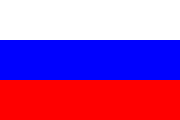 Krasnodar, Russia
Krasnodar, Russia Alexandroupolis, Greece
Alexandroupolis, Greece Miskolc, Hungary
Miskolc, Hungary
Climate table
| Jan | Feb | Mar | Apr | May | Jun | Jul | Aug | Sep | Oct | Nov | Dec | Year | ||
|---|---|---|---|---|---|---|---|---|---|---|---|---|---|---|
| Mean daily maximum temperature (°C) | 5.9 | 8.9 | 17.8 | 20.7 | 25.3 | 27.4 | 30.2 | 30.0 | 26.4 | 20.6 | 11.6 | 6.1 | 19.2 | |
| Mean minimum night time temperature (°C) | -2.1 | 0.9 | 3.3 | 6.8 | 10.0 | 15.9 | 20.8 | 21.4 | 19.4 | 14.7 | 8.2 | −1.4 | 9.8 | |
| Mean total rainfall (mm) | 11 | 14 | 32 | 51 | 40 | 44 | 21 | 9 | 8 | 13 | 28 | 31 | 25.1 | |
| Mean number of rain days | 10 | 10 | 10 | 11 | 4 | 5 | 2 | 3 | 5 | 3 | 9 | 11 | 6 | |
| Source: World Weather Information Service | ||||||||||||||
See also
- List of cities in Bulgaria
- Bulgarian Black Sea Coast
- Lake Burgas
- Burgas Airport
External links
- Burgas City Official Website
- Burgas largest website, Information about Burgas
- Factor Newspaper, Bourgas news
- Burgas Regional Administration
- Nikola Gruev's gallery of Burgas
|
|||||||
|
|||||
|
||||||||||||||
